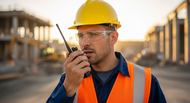What Should You Look for When Buying Two-Way Radios for Construction Workers?
If you work in construction, then you already know that clear communication is everything. Shouting over the roar of heavy machinery or relying on cellular phones that can lose signal on-site just doesn’t cut it.
This is a gap that two-way radios perfectly fill: they keep everyone connected, safe, and productive. However, not all two-way radios are built the same. Before you grab the first set you see online, read on below for a breakdown of what really matters when choosing two-way radios for construction workers:

Durability Matters Most
Construction sites are tough environments, which means that the radios you choose need to be just as tough. The last thing you want to buy is a fragile device that stops working after the first drop or rain shower.
Look for radios that are built to handle dust, water, and accidental impacts. Many professional-grade radios have IP ratings, which tell you how resistant they are to dust and water. For construction sites, a radio with at least IP54 or higher is the ideal choice. The rating signifies that it’s protected from dust and can handle splashes or a bit of light rain.
Range and Signal Strength
Communication doesn’t mean much if the person on the other end can’t hear you. The range you need will depend on the size of your job site: if you’re working on a small residential build, you might not need a long range. For large commercial projects where crews are spread over multiple levels or wide open areas, though, you’ll want radios with a strong signal that can cut through obstacles such as walls, equipment, and terrain.
One thing that’s worth keeping in mind here is that manufacturer range estimates are often based on ideal, open-field conditions. Real-world results are usually shorter.
Battery Life for Long Shifts
Shifts at a construction site can run eight, ten, or even twelve hours. This means that the last thing you want is a radio that’s dead halfway through the work day. Long battery life is crucial, especially if your team can’t stop frequently to recharge.
Radios with rechargeable lithium-ion batteries are the ideal choice, as they’re known for lasting longer and charging faster than older battery types. Alternatively, go for models that allow you to swap batteries easily. That way, you only need to keep spare batteries charged and ready to go anytime.
Clear Audio Quality
A good radio doesn't just connect you; it makes sure you're heard loud and clear. Background noise from drills, saws, and trucks can make communication a nightmare if your radio’s audio isn’t up to par.
Choose radios with noise-canceling features and strong speakers so that voices can come through loud and clear. Some radios also have adjustable volume levels, which can make a big difference when noise levels change throughout the day.
Ease of Use
No one wants to waste time figuring out complicated controls while they’re on the clock. Radios should be simple enough that workers can operate them with gloves on, without scrolling through endless menus. A clear display, big buttons, and intuitive channels are all features that make radios more user-friendly.
Extra Features Worth Considering
Once you’ve covered the basics, a few extra features can really make your team’s day easier. Hands-free operation with headsets keeps workers focused on the job while staying in touch. Emergency alert functions can improve site safety by quickly notifying everyone when something goes wrong. Some radios even have privacy codes that reduce interference from other nearby radios, which is helpful if multiple crews are working in the same area.

Tech Wholesale’s Top Two-Way Radio Picks for Construction Workers, Based on Site Size
Here at Tech Wholesale, we carry an extensive selection of two-way radios for construction workers from brands like Motorola and Kenwood. Below are our top picks based on the size of your construction site:
For Smaller Sites
For smaller sites, we recommend the Motorola RMU2080d, one of the most durable radios on the market. It has a massive 8 channels that should allow you to segment a large staff, two watts of power (ideal for smaller sites), and a rechargeable lithium-ion battery. The Motorola RMU2080d also offers reliable outdoor communications for up to 2 miles and an indoor range of 20 floors or 250,000 square feet.
Additionally, the RMU2080d works on 99 UHF business exclusive channels and 219 PL/DPL codes, so your communications are going to be protected. It also doesn’t break a sweat if you need comms that can get around steel and concrete. Finally, it’s made from a military standard design that can handle dust, wind, shock, vibration, and more.
Alternatively, if you’re looking for a radio that’s simple and tough, check out the Kenwood NX-P1300AUK. With UHF frequencies and 2 watts of power, it provides a strong signal for both indoor and outdoor settings. This radio is also equipped with 64 channels, allowing you to effectively manage larger teams.
For Larger Sites / Multiple Buildings
For larger sites, our top recommendation is the Motorola CP100d-UD series. It offers extended coverage with its larger antenna and is a durable choice. Some of its standout features include offering 160 channels, having four watts of power (ideal for larger sites), and it can cover sites up to 400,000 square feet and up to 30 floors in a building. Should your buildings have dead spots or if you require extra wide coverage, both the CP100d-UA and CP100d-UD also come repeater ready.
The Motorola CP100d-UD series is also upgradable to digital, allowing you access to flexible call options (private reply, direct call) and get further range.
Buying two-way radios for construction workers isn’t just about picking the cheapest option. It’s about finding reliable tools that help your team stay safe, efficient, and connected throughout the workday. Focus on durability, range, battery life, and audio clarity first, then look at extra features that fit your crew’s needs. When you invest in the right radios, you’re really investing in smoother communication — and that makes every job site run a whole lot better.

